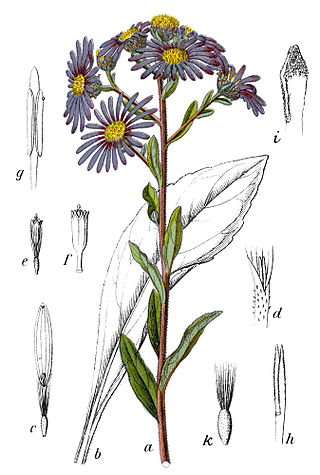Harold Ernest Robinson was an American botanist and entomologist.

Liatris, commonly known as gayfeather and blazing star is a genus of flowering plants in the tribe Eupatorieae within the family Asteraceae native to North America. Some species are used as ornamental plants, sometimes in flower bouquets. They are perennials, surviving the winter and resprouting underground corms.

The Heliantheae are the third-largest tribe in the sunflower family (Asteraceae). With some 190 genera and nearly 2500 recognized species, only the tribes Senecioneae and Astereae are larger. The name is derived from the genus Helianthus, which is Greek for sun flower. Most genera and species are found in North America and South America. A few genera are pantropical.

Eupatorium is a genus of flowering plants in the family Asteraceae, containing from 36 to 60 species depending on the classification system. Most are herbaceous perennials growing to 0.5–3 m (1.6–9.8 ft) tall. A few are shrubs. The genus is native to temperate regions of the Northern Hemisphere. Most are commonly called bonesets, thoroughworts or snakeroots in North America. The genus is named for Mithridates Eupator, king of Pontus.

Eupatorieae is a tribe of over 2000 species of plants in the family Asteraceae. Most of the species are native to tropical, subtropical, and warm temperate areas of the Americas, but some are found elsewhere. Well-known members are Stevia rebaudiana, a number of medicinal plants (Eupatorium), and a variety of late summer to autumn blooming garden flowers, including Ageratum (flossflower), Conoclinium (mistflower), and Liatris.

Brickellia is a North American genus of about 100 to 110 species of plants in the family Asteraceae, known commonly as brickellbushes. They are found in Canada, the United States, Mexico, and Central America. Many species are native to the American southwest, especially Texas. Brickellia is among the more basal lineages of the Eupatorieae and should not be assigned to a subtribe pending further research.

Eutrochium is a North American genus of herbaceous flowering plants in the family Asteraceae. They are commonly referred to as Joe-Pye weeds. They are native to the United States and Canada, and have non-dissected foliage and pigmented flowers. The genus includes all the purple-flowering North American species of the genus Eupatorium as traditionally defined, and most are grown as ornamental plants, particularly in Europe and North America.

Asteroideae is a subfamily of the plant family Asteraceae. It contains about 70% of the species of the family. It consists of several tribes, including Astereae, Calenduleae, Eupatorieae, Gnaphalieae, Heliantheae, Senecioneae and Tageteae. Asteroideae contains plants found all over the world, many of which are shrubby. There are about 1,135 genera and 17,200 species within this subfamily; the largest genera by number of species are Helichrysum (500–600) and Artemisia (550).

Chromolaena is a genus of about 165 species of perennials and shrubs in the family Asteraceae. The name is derived from the Greek words χρῶμα (khrôma), meaning "color", and χλαῑνα (khlaīna) or λαῑνα (laīna) meaning "cloak". It refers to the colored phyllaries of some species. Members of the genus are native to the Americas, from the southern United States to South America. One species, Chromolaena odorata, has been introduced to many parts of the world where it is considered a weed.
Carminatia is a genus of annual plants in the family Asteraceae. They are native primarily to Mexico, but also the southwestern United States and Central America.
Brickelliastrum is a North American genus of flowering plants in the tribe Eupatorieae within the family Asteraceae. Brickelliastrum has at times been lumped with Brickellia or Steviopsis, but chromosome number (x=10) and molecular data are in agreement in showing that it is distinct from either of these. Despite having the general appearance of Brickellia, members of Brickelliastrum have cypselae that have only 5-7 ribs (vs. 10), funnel-shaped corollas, and a style with an unenlarged, glabrous base.
Cronquistia is a genus of flowering plants in the daisy family, Asteraceae.
Mexianthus is a genus of Mexican flowering plants in the tribe Eupatorieae within the family Asteraceae.
Monogereion is a genus of Brazilian flowering plants in the tribe Eupatorieae within the family Asteraceae.
Siapaea is a genus of plants in the tribe Eupatorieae within the family Asteraceae.
Steviopsis is a genus of Mexican plants in the tribe Eupatorieae within the family Asteraceae.

Sphagneticola is a genus of flowering plants in the family Asteraceae. Creeping-oxeye is a common name for plants in this genus.
Guy L. Nesom is an American writer and botanist.
Brickellia kellermanii is a Mesoamerican species of flowering plants in the family Asteraceae. It is native to Central America and southern Mexico (Chiapas).
Brickellia diffusa is a Latin American species of flowering plants in the family Asteraceae. It is widespread across much of South America, Central America, Mexico, Galápagos, and the West Indies. Its distribution stretches from Sonora and Tamaulipas in northern Mexico to Jujuy in northern Argentina.








